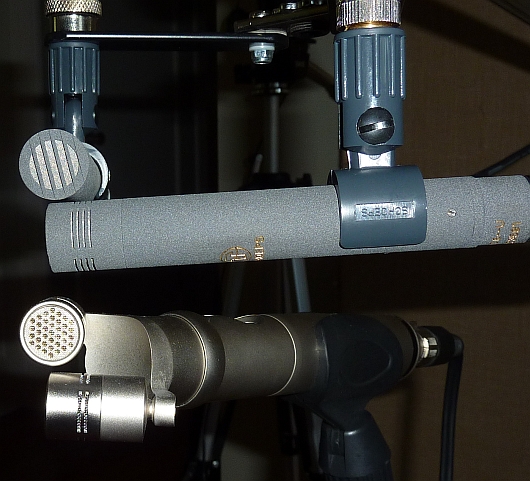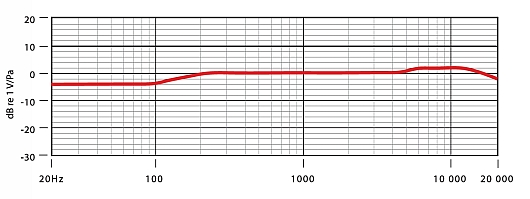As I’ve mentioned before, for many years I believed the recording advice I found on the internet. I visited recording forums and searched for discussions of acoustic guitar recording, and bought gear based on those discussions. I was never happy with my tracks, and I hoped that I could find the combination of gear that would make my recordings sound great.
One consistent recommendation was the Schoeps line of microphones. I was lucky enough to find a deal on a pair of used Schoeps CMC64s (CMC6 modular bodies and MK4 cardioid capsules) a few years ago, and even though they were fairly expensive I bought them because I knew that once I had a pair of Schoeps, I could no longer blame the microphones for my less than satisfactory results.
Now, a few years older and hopefully wiser, I have come to realize that the difference between most mics is pretty subtle, the difference between preamps and a/d converters is even more subtle, and the big differences come in the instrument, the performance, and the room. Of course, believing that equipment has a minor impact has not kept me from buying more gear. Mics and audio interfaces, monitors and headphones, sometimes I just can’t resist trying something new.
A New Toy (er, Tool)
Since I’ve discovered the fun of videography I’ve found even more gear to consider. The recent Homebrewed Music comparison of stereo mics for the Kodak Zi8 stimulated my interest in a microphone that is widely recommended as an excellent medium priced tool, the Rode NT4. This mic combines the two capsules and electronics of the Rode NT5 small diaphragm condenser in a single body visibly similar to the NT3 model. This mic includes the option of using a 9 volt battery for power if 48 (or 24) volt phantom power is not available. It also comes with adapter cables providing either a conventional pair of XLRs or a 1/8″ stereo miniplug for cameras and field recorders. The NT4 doesn’t come up on the used market very often, but with a little patience I found one at an attractive price and added it to my collection.
One thing about high end (that is, high priced) gear like the Schoeps mics, in my little home studio they tend to stay in the drawer. Since Schoeps prices have gone up steadily for the last few years, my mic collection has become an investment as well as tool set, and I’ve become a bit protective of the “good stuff.” If I need a mic for a quick recording, I’m much more likely to pull out a less expensive unit, and the NT4 has been getting plenty of use lately. It’s simple to set up, useful with various recording systems, and sounds pretty darned good to me.
Shootout Time
In fact, it sounded so good, I started wondering how it might compare to the hallowed Schoeps CMC64. Once I listened to them side by side, would I still think the NT4 sounded darned good? I’ve gone into some detail on the procedure needed for a meaningful mic test, and I’ve done some other comparisons. But a recent flurry of “what is the best mic” postings on various guitar forums triggered a desire to evaluate the Rode and Schoeps side by side.
Naturally, I set the mics up as close as possible to the same position, using the same stereo arrangement. The Rode is constructed as a fixed X-Y array, so I used a stereo bar to mount the CMC64 pair in the same configuration.
I connected both mic systems to the Echo Audiofire Pre8, and set the gain by eye. Next I setup Reaper to record two stereo tracks, and applied the Sonalksis FreeG meters to each track. This excellent plugin let me know that my preamp gain settings were within a couple of db of each other, as close as I am likely to get with the small gain controls of the Pre8. After recording, I pulled the files into Adobe Audition where I use the Group Waveform Normalize function to set the perceived average levels to – 12 dBFS.
It’s All in the Listening
Just listening to the tracks they sounded pretty similar, so I pulled the tracks into foobar2000 to use the ABX utility. Under this audio microscope I quickly discovered that I could recognize the files as different. The Rode recording was very (and I mean very) slightly “lighter,” less full than the Schoeps track. When I checked the frequency response curves I saw that the Rode had a reduced bass response and more pronounced emphasis on the highs compared to the MK4 capsule of the Schoeps.
I immediately wondered if I could reduce the difference with some EQ. Back into Adobe Audition, where I used the Parametric Filter, adjusted to the opposite of the Rode frequency response graph, to process the Rode track and save it to a new file.
After this processing, I could no longer tell the files apart when I ran ABX in foobar2000. In the first test I made six consecutive correct choices with no incorrect ones, a better than 85% certainty that I could tell them apart. When I compared the Rode file with EQ to the Schoeps file, my results fell apart, with three incorrect choices out of four tries.
Based on this test, it seems that a little digital EQ can make a Rode NT4 sound like a Schoeps CMC64 when recording me playing solo acoustic guitar (in this room on this day). This is not to say that an NT4 is “as good as” a pair of Schoeps mics, of course. The Schoeps modular system supports many different capsules for different pickup patterns and uses. And a pair of mics give much more flexibility in placement than a fixed X-Y stereo mic. But in this one very limited use, simple stereo recording of a solo acoustic guitar, the NT4 reduces the complexity and cost while delivering sonic results that I find completely satisfactory.
Try for yourself. Here are the files (these are CD spec 44.1 khz 16 bit PCM wave files, so they’re large – about 14 Mb each):
Download O.wav
Download P.wav
Download Q.wav
One of these is the Schoeps, one is the Rode without EQ, the other is the Rode with EQ. Ideally you’ll use an ABX tool to listen carefully and determine if you can tell the files apart. However you choose to listen, post a comment here with your impressions and I’ll email you the identity of the three files.
***** June 17, 2010 Update *****
When I posted links to these files on the Acoustic Guitar Forum the folks there quickly zeroed in on the Schoeps CMC64, so I went back to foobar2000 ABX and, sure enough, once I found the right place to listen, I could hear the difference between the Rode, even with EQ, and the Schoeps. Which goes to demonstrate an important aspect of ABX testing – it’s quite possible to miss differences, due to tiredness or predisposition or some other cause.






















